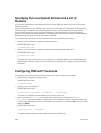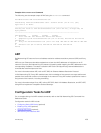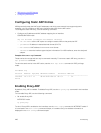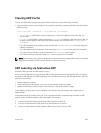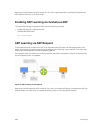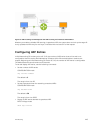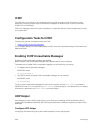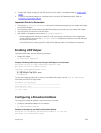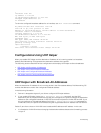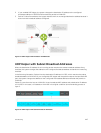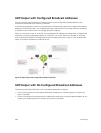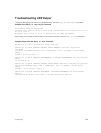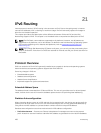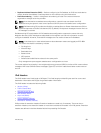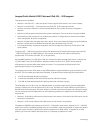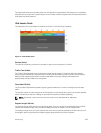
!
interface Vlan 100
ip address 1.1.0.1/24
ip udp-broadcast-address 1.1.255.255
untagged GigabitEthernet 1/2
no shutdown
To view the configured broadcast address for an interface, use show interfaces command.
R1_E600(conf)#do show interfaces vlan 100
Vlan 100 is up, line protocol is down
Address is 00:01:e8:0d:b9:7a, Current address is 00:01:e8:0d:b9:7a
Interface index is 1107787876
Internet address is 1.1.0.1/24
IP UDP-Broadcast address is 1.1.255.255
MTU 1554 bytes, IP MTU 1500 bytes
LineSpeed auto
ARP type: ARPA, ARP Timeout 04:00:00
Last clearing of "show interface" counters 00:07:44
Queueing strategy: fifo
Input Statistics:
0 packets, 0 bytes
Time since last interface status change: 00:07:44
Configurations Using UDP Helper
When you enable UDP helper and the destination IP address of an incoming packet is a broadcast
address, Dell Networking OS suppresses the destination address of the packet.
The following sections describe various configurations that employ UDP helper to direct broadcasts.
• UDP Helper with Broadcast-All Addresses
• UDP Helper with Subnet Broadcast Addresses
• UDP Helper with Configured Broadcast Addresses
• UDP Helper with No Configured Broadcast Addresses
UDP Helper with Broadcast-All Addresses
When the destination IP address of an incoming packet is the IP broadcast address, Dell Networking OS
rewrites the address to match the configured broadcast address.
In the following illustration:
1. Packet 1 is dropped at ingress if you did not configure UDP helper address.
2. If you enable UDP helper (using the ip udp-helper udp-port command), and the UDP
destination port of the packet matches the UDP port configured, the system changes the destination
address to the configured broadcast 1.1.255.255 and routes the packet to VLANs 100 and 101. If you
do not configure an IP broadcast address (using the
ip udp-broadcast-address command) on
VLANs 100 or 101, the packet is forwarded using the original destination IP address 255.255.255.255.
Packet 2, sent from a host on VLAN 101 has a broadcast MAC address and IP address. In this case:
1. It is flooded on VLAN 101 without changing the destination address because the forwarding process
is Layer 2.
446
IPv4 Routing



